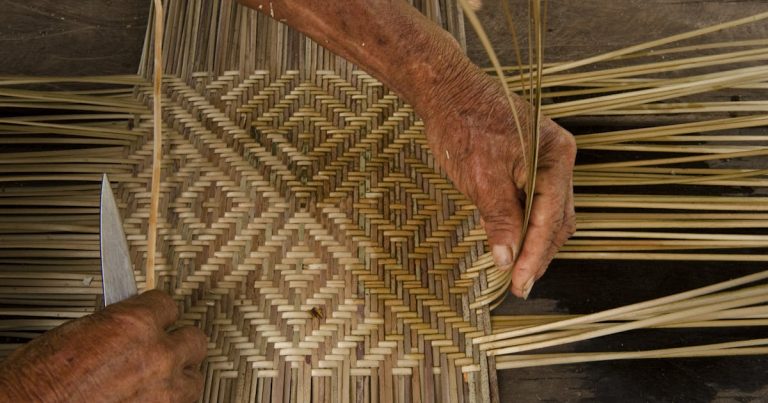When a news headline about the fashion industry includes the word “Indigenous,” it doesn’t often bode well for good news.
The fashion industry has had a historically difficult relationship with Indigenous people, but a new initiative aims to reset it.
As the fashion industry gathers this week for the Global Fashion Summit in Copenhagen, a newly released set of principles, with input from indigenous and local communities and led by Conservation International in partnership with industry group Textile Exchange, shows the industry how to work meaningfully with indigenous peoples and local communities while reducing the fashion industry’s impact on them.
A seat at the table
Let’s start here: Approximately 370 million indigenous peoples are scattered across 70 countries around the world, and their lands contain an estimated 80% of the world’s intact biodiversity. Collectively, they have proven to be effective stewards of ecosystems. From wool to leather to cotton, their lands produce a significant amount of the raw materials sought after by Western designers.
Yet when it comes to corporate sustainability, fashion and business, Indigenous peoples and local communities have long been left out of the conversation.
As a result, indigenous and local knowledge is not integrated into corporate sustainability strategies, indigenous intellectual property is not respected, and the fashion industry’s impacts on indigenous peoples and nature are generally ignored.
The data is clear: a Textile Exchange survey of 252 fashion companies found that less than 5% included indigenous peoples in their biodiversity plans.
Anecdotally, the gap is visibly clear: at a global fashion event in 2023, there was almost no discussion or representation of Indigenous peoples or their contributions to the fashion industry, according to observers of the event.
According to one expert, this wasn’t necessarily intentional, but rather a lack of knowledge and experience was the main culprit.
“A lot of companies don’t really know where to start to engage with Indigenous peoples,” said Quinn Manson Buchwald, a citizen of the Little Shell Tribe of Chippewa Indians of Montana and the Métis Confederation of Manitoba, and director of First Nations and Traditional Peoples programs at Conservation International. “There’s a really difficult relationship between the two, so I think the industry has been nervous about reaching out to build those relationships and how to do it right.”
This gap presented an opportunity for Buchwald and his colleagues at Conservation International, who began consulting with indigenous peoples and their organizations to understand and distill their preferences for how the fashion industry could work with them.
In the process, Buchwald said, it has brought attention to the influence of the fashion industry, including when it comes to appropriating Indigenous art and themes.
“We found that intellectual property issues affect local communities just as much as sourcing and environmental issues,” Buchwald says, “and in fact many indigenous peoples and local communities don’t see them as separate issues.”
One of the biggest issues to address was accountability, Buchwald said.
“The fashion industry doesn’t often track its sourcing within the value chain like other industries,” Buchwald said of the fashion industry, “so in many cases, they don’t even know the full extent of the industry’s impact on the land and communities.”
But this is starting to change, thanks in part to greater public awareness of the role of nature in value chains.
“The fashion industry is beginning to understand its impact on nature and biodiversity,” says Virginia Borchert, senior director of sustainable fashion at Conservation International, who worked with Buchwald to develop the principles, “so it makes sense that as the industry begins to implement these sustainability strategies, it will recognize that indigenous peoples are custodians of biodiversity.”
Practice
The principles aim to clarify some basics: How should we engage with Indigenous communities? What are best practices across the board, given the diversity within and between Indigenous groups?
At first glance, many of the guidelines’ principles seem intuitive: Adopt a partnership mindset. Get buy-in. Understand your impact.
But a number of principles show how unique and large some of the gaps are.
Some guidelines highlight indigenous peoples’ views of nature and natural places, such as on-site photoshoots, a staple of the fashion industry. The guidelines encourage fashion companies to be mindful of the impact of their location choices, as a place chosen for its beauty may also be culturally significant or ecologically fragile, risking further damage if many people decide to visit it because they saw it in a campaign.
Not surprisingly, part of the guidelines addresses Indigenous design, calling for consent and transparency regarding the use of Indigenous designs, and pricing that allows Indigenous people and local communities to purchase products that feature their designs. The guidelines also call for not using Indigenous designs in cheaply produced fashion, which devalues small Indigenous-led businesses that cannot compete with low-cost manufacturing.
The guidelines also lay the foundation for investment in Indigenous communities, including providing training, resources and support to ensure they can fully participate in the design, production and marketing of fashion products.
The final draft of the principles was finalized and approved by Indigenous and local community partners.
Borchert says that while the principle is new, the problem it aims to solve is not.
“Indigenous fashion is not new. Indigenous presence in the fashion industry is not new. Indigenous perspectives and leadership are new in a consistently Eurocentric, non-Indigenous space where global supply chains impact Indigenous lives and the lives of communities.”
Bruno Vander Velde is Managing Director of Content at Conservation International. Want to read more articles like this? Sign up for email updates and consider supporting our important work.


